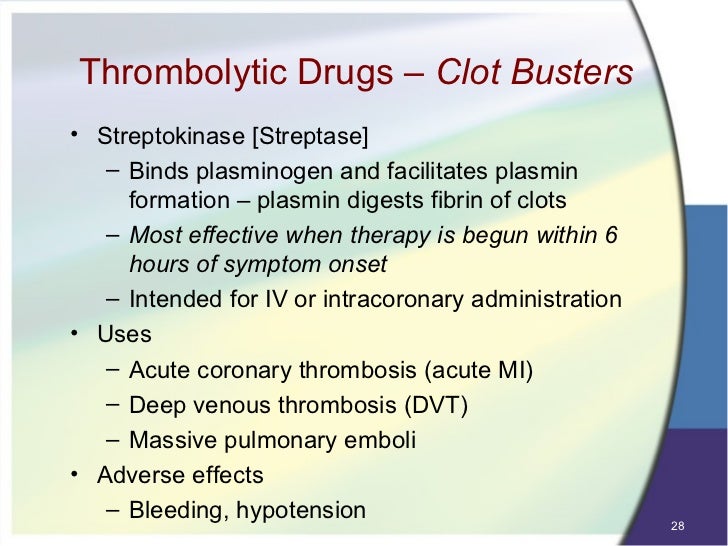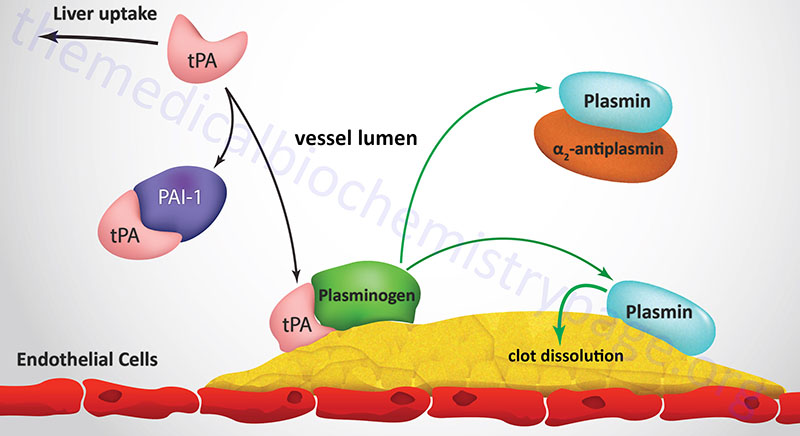Tpa Clot Dissolver
- Natural Clot Dissolvers
- Tpa Clot Buster
- Tpa Clot Busting Drug
- Tpa Clot Dissolver
- Clot Dissolvers Thrombolytics
Tissue plasminogen activator (abbreviated tPA or PLAT) is a protein involved in the breakdown of blood clots. It is a serine protease (EC 3.4.21.68) found on endothelial cells, the cells that line the blood vessels. As an enzyme, it catalyzes the conversion of plasminogen to plasmin, the major enzyme responsible for clot breakdown. Patients who don’t get to the hospital within 90 minutes of stroke symptoms starting may not be eligible to receive an effective “clot-busting” drug called tPA. TPA quickly dissolves the clots that cause many strokes. So when a powerful clot-clearing drug called tPA (tissue plasminogen activator) was approved by the Food and Drug Administration in 1996, it was a game-changer in the treatment of ischemic strokes, which afflict about 795,000 people each year in the United States. Fast-forward to today: Many tPA candidates are not getting the drug. Alteplase is a thrombolytic (THROM-bo-LIT-ik) drug, sometimes called a 'clot-busting' drug. It helps your body produce a substance that dissolves unwanted blood clots. Alteplase is used to treat a stroke caused by a blood clot or other obstruction in a blood vessel.
Natural Clot Dissolvers
DEAR DOCTOR K:
My father recently had an ischemic stroke. He was treated with tPA and has now fully recovered. What is tPA? And how does it work?
DEAR READER:
The most common kind of stroke is called an ischemic (is-KEY-mic) stroke: an artery supplying the brain becomes blocked by a blood clot. The part of the brain supplied by the artery needs the nutrition provided by a constant supply of blood. When that supply is interrupted, brain cells can die, taking with them the ability to move, speak, feel or think.
When a stroke occurs, immediate treatment is crucial. The sooner treatment starts, the better the chance of limiting disability or brain damage — or preventing death.

As soon as doctors diagnose an ischemic stroke, they must determine whether a clot is still blocking an artery. If so, there are drugs to dissolve the clot. Tissue plasminogen activator (tPA) is one of the main drugs used to dissolve clots. It is made naturally by the body, but unfortunately, when a clot suddenly blocks an artery, the body doesn’t make enough tPA to dissolve the clot.
However, tPA produced in the form of a medicine can be given through a thin tube in the arm or a tube threaded through the blood vessels directly to the site of the blockage. High concentrations of tPA build up at the site of the clot, making it dissolve. (I’ve put an illustration of how tPA works to restore blood flow to the brain below.)
How clot-busters workThrombolytic drugs such as tPA are often the first line of defense in treating some forms of ischemic stroke. The stroke occurs when fibrin strands in the blood trap blood cells and platelets, forming a clot in an artery to the brain (A). The drug breaks up the clot by helping generate the enzyme plasmin, which digests the fibrin strands, restoring blood flow (B). |
Dissolving a clot won’t help the brain if it’s done too late. The phrase doctors use is, “Time is brain.” To be effective, tPA should be administered within 4 1/2 hours after the start of the stroke. When used appropriately, tPA can produce dramatic recovery within hours.

Tpa Clot Buster
But clot-dissolving drugs also carry risks, and tPA can cause excessive bleeding — which can lead to death. The more time that passes between the start of the stroke and the administration of tPA, the greater this risk.
Tpa Clot Busting Drug
Clearly, doctors must exercise great caution when deciding whether to use tPA. When possible, this decision is best made by a skilled medical team headed by a stroke specialist.
If doctors rule out tPA, they will likely give an antithrombotic, or anticoagulant drug, such as heparin, to prevent more clots from forming.
When I was a young physician, there was very little we could do for people with ischemic strokes. We knew what the problem was — a clot had blocked a major artery in the brain — but we just had no way of dissolving it.
It took medical research to figure out how clots form and dissolve. Then the huge research breakthrough called recombinant DNA technology allowed us to make large amounts of natural substances like tPA. Without this research, most of it supported by your tax dollars, we would not have tPA, human insulin, or many other life-saving medicines. Think about that when you read about cuts in funding for medical research.
Tpa Clot Dissolver
Accessibility Statement
Clot Dissolvers Thrombolytics
We are committed to providing a website that is accessible to the widest possible audience. To do so, we are actively working with consultants to update the website by increasing its accessibility and usability by persons who use assistive technologiessuch as automated tools, keyboard-only navigation, and screen readers.
We are working to have the website conform to the relevant standards of the Section 508 Web Accessibility Standards developed by the United States Access Board, aswell as the World Wide Web Consortium's (W3C) Web Content Accessibility Guidelines 2.1. These standards and guidelines explain how to make web content more accessible for people with disabilities. We believe that conformance with these standards andguidelines will help make the website more user friendly for all people.
Our efforts are ongoing. While we strive to have the website adhere to these guidelines and standards, it is not always possible to do so in all areas of the website.If, at any time, you have specific questions or concerns about the accessibility of any particular webpage, please contact WebsiteAccess@tenethealth.com so that we may be of assistance.
Thankyou. We hope you enjoy using our website.